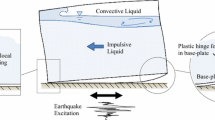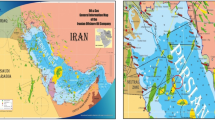Abstract
Remote detection of structural aging, degradation phenomena and damage due to hazardous events is critical to ensure safety and reliability of civil or industrial structures. This is the motivation of the rapid development and increasing application of fully automated structural health monitoring (SHM) systems in civil engineering. Modal-based damage detection currently represents a popular approach for SHM of civil structures. In fact, it is a global method for damage detection and, as such, the measurement locations are not required to be close to the damage. However, damage sensitive features defined in terms of modal parameter estimates are also influenced by environmental and operational factors. Thus, neglecting this influence might jeopardize the reliability of the technology. In this framework, the present paper investigates the potential of modal-based SHM to detect earthquake damage at anchors of an atmospheric liquid storage tank. To this aim, the influences of bolt loosening at supports and of liquid level on modal parameters are investigated. The ultimate goal of the present study is the definition of criteria for the effective design and application of modal-based SHM to liquid storage tanks.








Similar content being viewed by others
References
Salzano E, Agreda AG, Di Carluccio A, Fabbrocino G (2009) Risk assessment and early warning systems for industrial facilities in seismic zones. Reliab Eng Syst Saf 94(10):1577–1584
Housner GW (1963) The dynamic behavior of water tanks. Bull Seismol Soc Am 53(2):381–387
Haroun MA, Housner GW (1981) Seismic design of liquid storage tanks. J Tech Counc ASCE 107:191–207
Haroun MA, Housner GW (1982) Dynamic characteristic of liquid storage tanks. ASCE J Eng Mech Div 108:783–800
Di Carluccio A, Fabbrocino G (2012) Some remarks on the seismic demand estimation in the context of vulnerability assessment of large steel storage tank facilities. ISRN Civ Eng. https://doi.org/10.5402/2012/271414(Article ID 271414)
Veletsos AS (1984) Seismic response and design of liquid storage tanks. Guidelines for the seismic design of oil and gas pipeline systems, Technical Council on Lifeline Earthquake Engineering. ASCE, New York, pp 255–370
European Committee for Standardization (2006) Eurocode 8: design of structures for earthquake resistance. Part 4: Silos, tanks and pipelines. European Standard EN1998-4
Glisic B, Inaudi D (2004) Health monitoring of a full composite CNG tanks using long-gauge fiber optic sensors. In: Proceedings of the 11th SPIE’s Annual International Symposium on Smart Structures and Materials, 5384–5387, San Diego, USA
Park SW, Kang DH, Bang HJ, Park SO, Kim CG (2006) Strain monitoring and damage detection of a filament wound composite pressure tank using embedded fiber Bragg grating sensors. Key Eng Mater 321–323:182–185
Almahmoud S, Shiryayev O, Vahdati N, Rostron P (2018) Detection of internal metal loss in steel pipes and storage tanks via magnetic-based fiber optic sensor. Sensors 18(3):815
Shaheen YBI, Eltaly BA, Abd-Alla MK (2013) Damage detection of ferrocement tanks using experimental modal analysis and finite element analysis. Concr Res Lett 4(2):598–608
Curadelli O, Ambrosini D (2011) Damage detection in elevated spherical containers partially filled with liquid. Eng Struct 33:2708–2715
Zhou W, Wu Z, Mevel L (2010) Vibration-based damage detection to the composite tank filled with fluid. Struct Health Monit 9(5):433–445
Aslam M (1981) Finite element analysis of earthquake-induced sloshing in axisymmetric tanks. Int J Numer Methods Eng 17(2):159–170
Taghavi S, Miranda E (2003) Response assessment of nonstructural building elements. PEER report 2003/05. University of California Berkeley, Berkeley
World Health Organization, Regional Office for Europe (2006) Health facility seismic vulnerability evaluation—a handbook. WHO, Copenhagen
Myrtle RC, Masri SF, Nigbor RL, Caffrey JP (2005) Classification and prioritization of essential systems in hospitals under extreme events. Earthq Spectra 21(3):779–802
GeoHazards International (2009) Reducing earthquake risk in hospitals from equipment, contents, architectural elements and building utility systems. GeoHazards International, Menlo Park
Federal Emergency Management Agency (1997) FEMA 274, NEHRP commentary on the guidelines for the seismic rehabilitation of buildings. FEMA, Washington
American Society of Civil Engineers (2017) ASCE/SEI 4-16 seismic analysis of safety-related nuclear structures. American Society of Civil Engineers, Reston
Farrar CR, Worden K (2012) Structural health monitoring: a machine learning perspective. Wiley, Chichester, p 631
Peeters B, De Roeck G (2001) One-year monitoring of the Z24-Bridge: environmental effects versus damage events. Earthq Eng Struct Dyn 30:149–171
Rainieri C, Magalhaes F, Gargaro D, Fabbrocino G, Cunha A (2019) Predicting the variability of natural frequencies and its causes by second-order blind identification. Struct Health Monit 18(2):486–507
Reynders E, Wursten G, De Roeck G (2014) Output-only structural health monitoring in changing environmental conditions by means of nonlinear system identification. Struct Health Monit 13(1):82–93
Amini R, Warner G, Nayeb-Hashemi H (2005) Natural frequency analysis of liquid filled tanks. In: Proceedings of ASME 2005 international design engineering technical conferences and computers and information in engineering conference, Long Beach, CA, USA
Amiri M, Sabbagh-Yazdi SR (2011) Ambient vibration test and finite element modeling of tall liquid storage tanks. Thin-Walled Struct 49:974–983
Jaiswal OR, Kulkarni S, Pathak P (2008) A study on sloshing frequencies of fluid-tank system. In: Proceedings of the 14th World conference on earthquake engineering, Beijing, China
Brincker R, Zhang L, Andersen P (2001) Modal identification of output-only systems using frequency domain decomposition. Smart Mater Struct 10:441–445
Peeters B, De Roeck G (1999) Reference-based stochastic subspace identification for output-only modal analysis. Mech Syst Signal Process 13(6):855–878
Van Overschee P, De Moor B (1996) Subspace identification for linear systems: theory—implementation—applications. Kluwer Academic Publishers, Dordrecht
Reynders E, Schevenels M, De Roeck G (2014) MACEC 3.3 A Matlab toolbox for experimental and operational modal analysis—User’s manual. Report BWM-2014-06, Faculty of Engineering, Department of Civil Engineering, Structural Mechanics Section, Katholieke Universiteit Leuven, Leuven, Belgium
Rainieri C, Fabbrocino G (2014) Operational modal analysis of civil engineering structures: An introduction and guide for applications. Springer, New York
Haroun MA (1983) Vibration studies and tests of liquid storage tanks. Earthq Eng Struct Dyn 11(2):179–206
Reynders E, Pintelon R, De Roeck G (2008) Uncertainty bounds on modal parameters obtained from stochastic subspace identification. Mech Syst Signal Process 22:948–969
Reynders E, Maes K, Lombaert G, De Roeck G (2016) Uncertainty quantification in operational modal analysis with stochastic subspace identification: validation and applications. Mech Syst Signal Process 66–67:13–30
Allemang RJ, Brown DL (1982) A correlation coefficient for modal vector analysis. In: Proceedings of The 1st international modal analysis conference, Orlando, FL, USA, pp 110–116
Acknowledgements
The present work has been partially carried out in the framework of a broader research project issued by ASREM—Molise Region Health Authority, on safety and structural health monitoring of the regional health facilities. The financial supports to the research activities from ASREM, the DIBT-IMPACT (Integrated Monitoring of Pressurized and AtmospheriC Tanks) research program at the University of Molise, and the ReLuis-DPC Executive Project 2019–2021—WP6 are gratefully acknowledged. Edwin Reynders gratefully acknowledges the financial support of the Research Foundation Flanders (FWO), Belgium, through the research project G099014N.
Author information
Authors and Affiliations
Corresponding author
Additional information
Publisher's Note
Springer Nature remains neutral with regard to jurisdictional claims in published maps and institutional affiliations.
Rights and permissions
About this article
Cite this article
Rainieri, C., Gargaro, D., Reynders, E. et al. A study on the concurrent influence of liquid content and damage on the dynamic properties of a tank for the development of a modal-based SHM system. J Civil Struct Health Monit 10, 57–68 (2020). https://doi.org/10.1007/s13349-019-00369-0
Received:
Revised:
Accepted:
Published:
Issue Date:
DOI: https://doi.org/10.1007/s13349-019-00369-0




